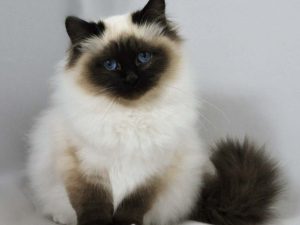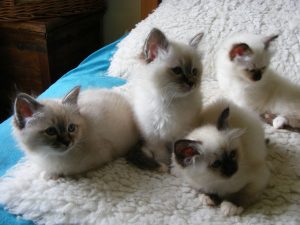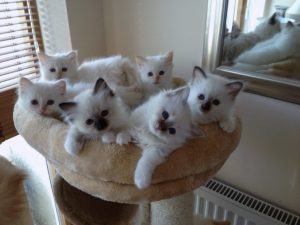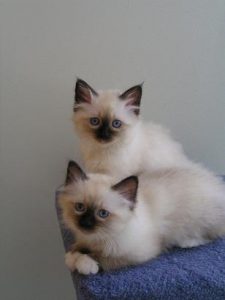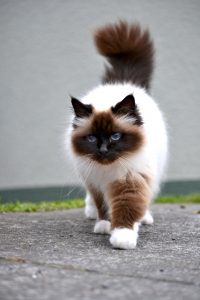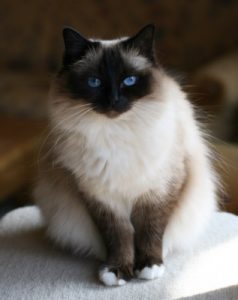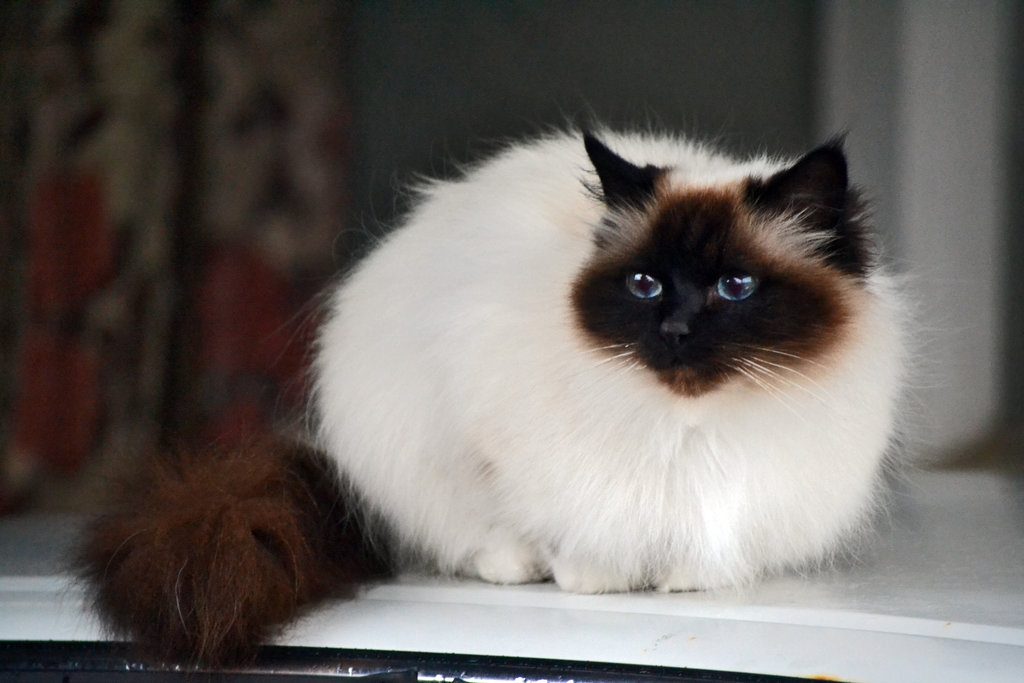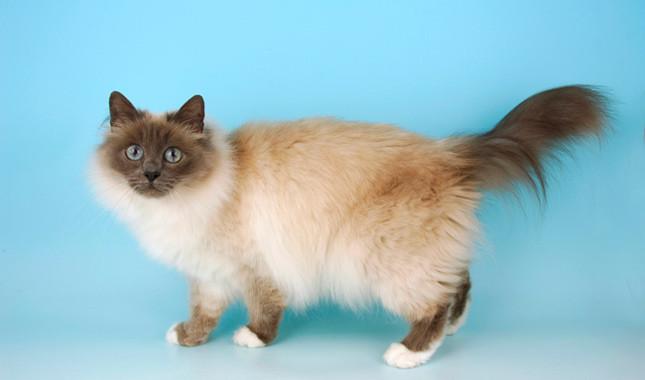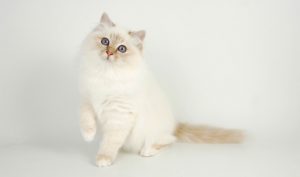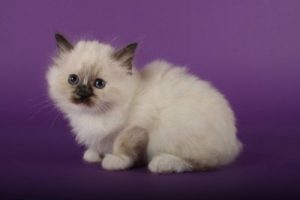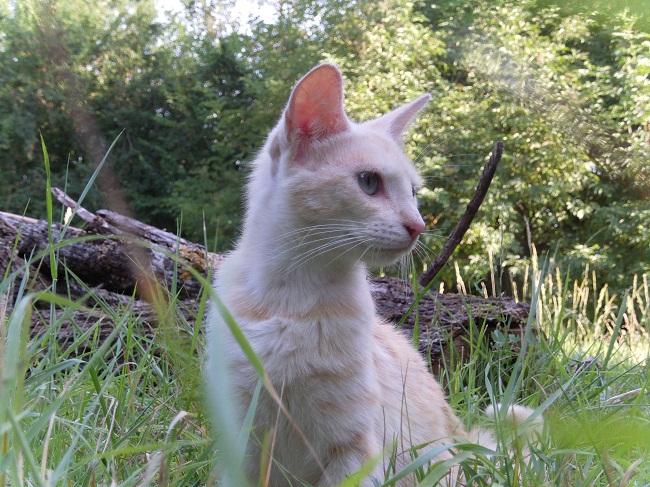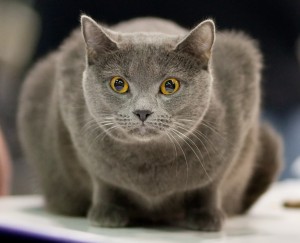Birman Cat
The Birman Cat, which is considered as the ‘sacred cat of Burma’, was actually developed in France. Unlike most other long-hair breeds, the long coat hair of this cat is standing pointed, and not lying loosely over its body. The hair is light-colored with a gold hue, with all the four feet having white gloves, and white laces at the back of their hind feet. The faces of these stocky, cute creatures are usually dark in contrast to the rest of their body. Their ears are dark and erect, and eyes are deep sapphire blue.
Quick Information
Physical Appearance & Size
| Weight: | 9 – 15 pounds |
Colors & Patterns
| Coat Type: | Soft, silky, long |
| Color: | White, blue, chocolate, lilac, seal, spotted |
| Coat Pattern: | Colorpoint |
Other Characteristics
| Also known as: | Sacred Birman |
| Life Expectancy (Lifespan): | 14 to 15 years |
| Litter Size: | 3 kittens (average) |
| Personality Traits: | Peaceful, gentle, quiet, loving, friendly, playful |
| Shedding: | Average |
| Good with Children: | Yes (over six years) |
| Hypoallergenic: | No |
| Vocalization: | Less, low |
| Country of Origin: | France |
| Competitive Registration/Qualification Information: | TICA, FIFe, CFA, ACF, CCA, ACFA/CAA |
History
The first Birman cats were first developed in France back in 1919. At this time, these cats were named by a French cat registry as the Sacre de Birmanie (or, ‘The Sacred Cat of Burma’). It was this root name from which the modern day ‘Birman Cat’ got its shortened name.
As a breed, these cats were almost wiped out during World War II, with only two cats remaining in Europe. This pair of Birmans, named Xenia de Kaabaa and Orloff both belonged to Baudoin-Crevoisier. After the end of the world war, they were heavily crossed with other long-hair breeds like the Persian cat and the Siamese cat, with an aim to bring back the Birman breed. The post-war Birmans were all offspring of this pair.
In 1967, the Birman cats entered the realms of the United States for the first time. The breed soon became popular and in 1967, it got recognition from the Cat Fanciers Association, with its current CFA ranking being nine.
Temperament and Personality
This colorpoint cat has a wonderful, friendly disposition. With all their virtuous traits of friendliness, peacefulness, refinement, they make the perfect family cat.
They enjoy the company of people, including children, and even other pets and can peacefully co-exist with other cats. The Birman will greet strangers with curiosity rather than fear. They love to be cuddled by its family members and would relax on their arms. They are usually quiet, although, if you reply to its occasional calls, your pet might get garrulous.
Birmans are territorial, but not aggressive. Unlike the Siamese, the Birman is not at all bossy. Although they are smart enough, as also curious, and would explore the environment frequently. This is one breed that normally remains at ground level, and not the climbing type, which means, your show pieces and displays on high shelves are safe from your Birman.
You Birman would always try to help you with washing your dishes, making your bed, working on your computer and all that you do. It will be by your side and would never let you feel alone. They are affectionate by temperament and would offer you its love in return for a little care and attention.
Care
The Birman is an average shedder and has a single coat. The long coat type of the cat needs much attention. Brush your pet with a soft-bristle brush at least 2-3 times a week, or else they might end in developing knotty hair. It is also suggested to bathe your Birman once at the end of every season, which should be enough for it to get rid of the dead hairs. But do not use cheap products, since that might leave stains on your cat’s light-color coat.
The most common threat to the Birman’s health is feline HCM (hypertrophic cardiomyopathy). Although a common cat disease, but it is thought to have been inherited as a trait that is autosomally dominant. This might lead to cardiac failure, paralyzed hind legs, and even sudden death. Birmans are also prone to obesity, skin diseases, and developing hairballs in the stomach like most other long-hair cats.
Training
With its noble, obedient, affectionate nature this gentle cat is born-‘trained’. No breed-specific training is recommended for your Birman cat. Right from the time of adoption, help your kitties learn your at-home rules and prescripts, those that you think is necessary for a cat to learn before it starts to live with its human family.
Diet
They are not much an active breed, and they tend to gain weight fast and suffer from obesity. Hence, keep a strong check on its food and food habits.
As a responsible owner, just keep in mind, they love to eat. So, never allow your curious Birman to discover the existence of smoked tuna, salmon, prawns, pate, etc., or else you might end in high food bills for your feline companion. Otherwise, it is very easy to feed the Birmans.
Only a wholesome feline dietary plan, just like other cat breeds of its size and energy levels, is enough for them to stay healthy.
Interesting Facts
- Legend says that, these cats descended from the Burmese temple cats that were raised by the Kittah priests, and hence such a name.
- Birman cats are intelligent enough to spend time playing with puzzle toys.
- Because these are French cats, Birman breeders often follow a French convention in naming the kittens. In this convention, kittens born in a particular year would be given names beginning with a common alphabet, e.g. kittens born in 2013 would have names with ‘K’, and those in 2014 would have with ‘L’, and so on.
- The name of the Birman cat has been derived from the word ‘Birmanie’, which is French form of the word ‘Burma’.
- As a breed, these fluffy cats got the very first recognition in France back in 1925 by the Cat Club de France.
- The Birman cats should have all the four feet white, with a specific pattern known as “gloves and laces”.
- The Birman cat is in the Top-10 favorite cats list in the USA.

